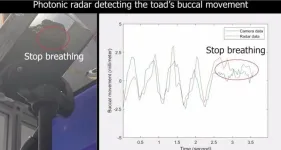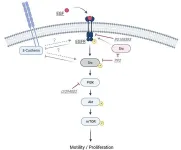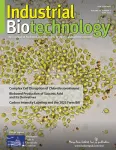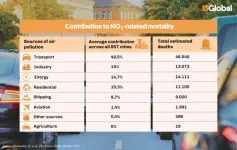(Press-News.org) Constant monitoring of vital health signs is needed in a variety of clinical environments such as intensive care units, for patients with critical health conditions, health monitoring in aged care facilities and prisons, or in safety monitoring situations where drowsiness can cause accidents.
This is now mostly achieved via wired or invasive contact systems. However, these are either inconvenient or, for patients with burns or for infants with insufficient skin area, are unsuitable.
Scientists at the University of Sydney Nano Institute and the NSW Smart Sensing Network have now developed a photonic radar system that allows for highly precise, non-invasive monitoring.
The research is published today in Nature Photonics.
Using their newly developed and patented radar system, the researchers monitored cane toads and were able accurately to detect pauses in breathing patterns remotely. The system was also used on devices that simulate human breathing.
The scientists say this demonstrates a proof of principle for using photonic radar that could enable the vital-sign monitoring of multiple patients from a single, centralised station.
The University of Sydney Pro-Vice-Chancellor (Research) and lead for this research Professor Ben Eggleton said: “Our guiding principle here is to overcome comfort and privacy issues, while delivering highly accurate vital sign monitoring.”
An advantage to this approach is the ability to detect vital signs from a distance, eliminating the need for physical contact with patients. This not only enhances patient comfort but reduces the risk of cross-contamination, making it valuable in settings where infection control is crucial.
“Photonic radar uses a light-based, photonics system – rather than traditional electronics – to generate, collect and process the radar signals. This approach allows for very wideband generation of radio frequency (RF) signals, offering highly precise and simultaneous, multiple tracking of subjects,” said lead author Ziqian Zhang, a PhD student in the School of Physics.
“Our system combined this approach with LiDAR – light detection and ranging. This hybrid approach delivered a vital sign detection system with a resolution down to six millimetres with micrometre-level accuracy. This is suitable for clinical environments.”
Alternate approaches to non-contact monitoring have typically relied on optical sensors, using infrared and visible wavelength cameras.
“Camera-based systems have two problems. One is high sensitivity to variations in lighting conditions and skin colour. The other is with patient privacy, with high-resolution images of patients being recorded and stored in cloud computing infrastructure,” said Professor Eggleton who is also the co-Director of the NSW Smart Sensing Network.
Radio frequency (RF) detection technology can remotely monitor vital signs without the need for visual recording, providing built-in privacy protection. Signal analysis, including identification of health signatures, can be performed with no requirement for cloud storage of information.
Co-author Dr Yang Liu, a former PhD student in Professor Eggleton’s team, now based at EPFL in Switzerland, said: “A real innovation in our approach is complementarity: our demonstrated system has the capability to simultaneously enable radar and LiDAR detection. This has inbuilt redundancy; if either system encounters a fault, the other continues to function.”
Conventional RF radar systems, which rely entirely on electronics, have narrow RF bandwidth and therefore have lower-range resolution. This means they cannot separate closely located targets or distinguish them in a cluttered environment.
Relying solely on LiDAR, which uses much shorter light wavelengths, provides improved range and resolution, but has limited penetration abilities through objects such as clothes.
“Our proposed system maximises the utility of both approaches through integrating the photonic and radio frequency technologies,” Mr Zhang said.
Working with collaborators and partners in the NSW Smart Sensing Network, the researchers hope this research provides a platform to develop a cost-effective, high-resolution and rapid-response vital sign monitoring system with application in hospitals and corrective services.
“A next step is to miniaturise the system and integrate it into photonic chips that could be used in handheld devices,” Mr Zhang said.
DOWNLOAD photos at this link. VIEW for embedding YouTube explainer video at this link.
INTERVIEWS
Professor Ben Eggleton Mr Ziqian Zhang
Sydney Nano and School of Physics Sydney Nano and School of Physics
The University of Sydney The University of Sydney
benjamin.eggleton@sydney.edu.au ziqian.zhang@sydney.edu.au
MEDIA ENQUIRIES
Marcus Strom | +61 423 982 485 | marcus.strom@sydney.edu.au
DECLARATION
The research was in part supported by grants from the Australian Research Council, the US Air Force and the US Office of Naval Research.
ADDITIONAL INFORMATION
PHOTONIC RADAR Q&A with Ziqian Zhang: HOW IT WORKS
What is photonic radar: Photonic radars, also known as microwave photonic radars or photonics-assisted radars, are radar systems that use photonic technologies to enhance the performance of traditional electronic radar systems. This means its systems use photons – light energy at high frequency – rather than electrons and electricity to generate the radio waves. It is crucial to recognise that despite incorporating photonics techniques, these systems still rely on radio waves or microwaves for the sensing.
How it works: Traditional electronic radar systems process and transmit radar signals within the electrical domain, utilising electronic components. In contrast, photonic radar systems employ technologies that enable the conversion between electronic and optical signals. This allows them to harness the power of modern photonics for processing RF (radio frequency) signals within the optical domain. Additionally, photonic radar systems can distribute these signals over long distances with minimal loss and distortion, thanks to the properties of optical fibres.
What are the advantages: Optical signals can carry more information than conventional electronic signals. When we use optical signals for radar signal generation, processing, and distribution (photonic radar), the system tends to have a wider radar bandwidth and better signal quality. This delivers exceptional range resolution and sensing precision. The range resolution refers to the minimum distance between targets that the radar system can separate apart. Our photonic system has a millimetre-level range resolution, thus can separate closely located subjects and extract their vital signs without interference with each other. Meanwhile, the high sensing precision, thanks to the high-quality signal generation, ensures vital sign detection accuracy.
Compared with conventional electronic radar systems: The photonic radar system enables distributed, multi-band sensing with expanded signal coverage. This results in superior radar performance from a centralised system, facilitating improved coordination and lower costs without the need to employ multiple independent systems and synchronise them together.
Hybrid Radar-LiDAR System: A noteworthy innovation in our demonstrated system is its capability to simultaneously enable both radar and LiDAR detection as a sensor fusion system, combining different sensor modalities.
Here are the key advantages:
Redundancy: If either the radar or LiDAR system encounters a fault, the other continues to function, ensuring uninterrupted performance.
Complementarity: Information garnered from the radar and LiDAR systems can supplement each other.
What is the next plan? We could continue investigating the use of on-chip components to shrink the device's footprint or test its performance with human subjects, possibly those with identified lung diseases or heart conditions. Another prospect is delving into advanced algorithms to boost the system's performance for moving subjects in real-world application scenarios, such as in aged-care facilities.
Potential application scenarios: Our photonic radar sensor boasts a broad array of applications spanning the corrective services sector, national security, MedTech, aged care, home care, livestock and veterinary uses, and healthcare. END
The device that can remotely and accurately monitor breathing: as tested on cane toads
Cane toad breathing monitored using ‘photonic radar’ at millimetre scale | Proof of principle for human vital-sign detection in clinical environments
2023-06-30
ELSE PRESS RELEASES FROM THIS DATE:
Rising monkey and pig populations pose human disease risk
2023-06-30
Exploding populations of wild pigs and macaque monkeys in Southeast Asia are threatening native forests and disease outbreaks in livestock and people, according to research led by The University of Queensland.
Dr Matthew Luskin, from UQ’s School of the Environment, and his team collated and analysed species population data from across the region, some of it collected with a network of cameras.
“Macaques and wild pigs are taking over Southeast Asia’s disturbed forests,” Dr Luskin said.
“Humans are largely to blame for this by altering forests with logging ...
KOSÉ and Niigata University develop a three-dimensional epithelial model that reproduces the human lip area
2023-06-30
Niigata, Japan - KOSÉ Corporation (Headquarters: Chuo-ku, Tokyo; President: Kazutoshi Kobayashi) has developed in collaborative research with Professor Kenji Izumi and his colleagues at Niigata University Graduate School of Medical and Dental Sciences (Faculty of Dentistry) a three-dimensional epithelial model that reproduces the human lip area from the oral mucosa to the lips and surrounding skin, using cell culture.
The lips are one of the most important elements that determine the impressions of the face, and they are also an area where many people suffer from problems, ...
Revolutionizing regenerative medicine: Unlocking the healing power of oral keratinocytes
2023-06-30
Niigata, Japan—Scientists have made significant progress in understanding the signals involved in regulating oral keratinocyte cell motility and proliferative capacity, offering new insights into potential pharmacological manipulation for regenerative medicine. A recent study, published in FEBS Open Bio, elucidated the role of the epidermal growth factor (EGF) and its downstream signaling cascade in controlling the behavior of oral keratinocytes.
Oral keratinocytes, which play a crucial role in the formation of the oral mucosa epithelial cell sheet, have long been enigmatic in terms of their signaling ...
Long COVID is not a single condition, study finds
2023-06-30
Long COVID is not a single condition, and should not be treated as such, according to new data collected in nationwide study released May 31 in the Open Forum of Infectious Diseases.
The study looked at persistent symptoms experienced by patients with COVID-19 both at three- and six-month intervals. In all, 5,963 patients participated in the study, with 4,504 of the participants testing positive for COVID-19 and 1,459 testing negative. Many of the participants, 2,000 in all, came from King County through the University of Washington School of Medicine.
The four major symptom categories for people who tested positive for COVID-19 included:
Minimal ...
Loneliness linked with elevated risk of cardiovascular disease in patients with diabetes
2023-06-30
Sophia Antipolis, 30 June 2023: Loneliness is a bigger risk factor for heart disease in patients with diabetes than diet, exercise, smoking and depression, according to research published today in European Heart Journal, a journal of the European Society of Cardiology (ESC).1
“The quality of social contact appears to be more important for heart health in people with diabetes than the number of engagements,” said study author Professor Lu Qi of Tulane University School of Public Health and Tropical Medicine, New Orleans, US. “We should not downplay the important of loneliness ...
TGI-led research finds climate change, increasing population put Kenya at risk of famine
2023-06-30
ST. LOUIS - Research published in Outlook on Agriculture has shown that the population relative to available climate-suitable areas in Kenya has increased, posing a threat to the country’s economy and food security.
The study, “Spatial changes to climate suitability and availability of agropastoral farming systems across Kenya (1980-2020),” was published online on May 29.
The research team analyzed Kenya’s farming systems and climate zones between 1980-2020. Over that time, the population ...
Status of biobased production of succinic acid and derivatives
2023-06-30
The current status and future perspectives on the successful industrialization of biobased succinic acid are discussed in a comprehensive review article in the peer-reviewed journal Industrial Biotechnology. Click here to read the article now.
Succinic acid is one of the most important platform chemicals, with applications as a pharmaceutical ingredient, food additive, precursor of various chemicals, and raw material for biobased polymers. There is increasing demand for the sustainable production of succinic acid and its derivatives.
Sang Yup Lee, from the Korea Advanced Institute of Science and Technology (KAIST), and coauthors, review ...
Nearly half of tuberculosis cases in prisons worldwide go undetected
2023-06-30
In the first global assessment of TB among incarcerated people, a new study found consistently high TB case rates and low case detection in prisons, suggesting the need for health organizations to increase efforts to reduce the spread of TB among this high-risk population.
In 2019, incarcerated people across the globe developed tuberculosis (TB) at nearly 10 times the rate of people in the general population, according to a new study led by Boston University School of Public Health (BUSPH).
Published in The Lancet Public Health, the study found that 125,105 of the 11 million people incarcerated worldwide developed tuberculosis in 2019, ...
Non-invasive approach predicts retinopathy of prematurity earlier
2023-06-30
Research from Ann & Robert H. Lurie Children’s Hospital of Chicago promises to spare many premature infants from undergoing invasive eye exams to detect retinopathy of prematurity (ROP), the most common cause of preventable lifelong blindness in children in the U.S.
ROP is caused by an abnormal development of small blood vessels on the retina. Isabelle De Plaen, MD, and colleagues found that imaging the capillaries in the nailbed of preemies within the first month of life using a non-invasive technique, called nailbed capillaroscopy, can identify infants at high risk for developing ROP. This screening could eliminate the need to evaluate all premature infants with eye exams ...
Transport, domestic activities and agriculture are the main contributors to air pollution related mortality in European cities
2023-06-30
Air pollution is the largest environmental cause of death. Now, a study led by the Barcelona Institute for Global Health (ISGlobal), a centre supported by the "la Caixa" Foundation, has estimated which sources contribute most to the mortality associated with two air pollutants - PM2.5 and NO2 - in 857 European cities.
The results of this research, which have been published in The Lancet Public Health, show great variability between the different cities studied, suggesting that, given that each one has its own particularities and its own sources of air pollution, strategies to improve air quality should be adapted to each local context.
Contributors ...
LAST 30 PRESS RELEASES:
Making lighter work of calculating fluid and heat flow
Normalizing blood sugar can halve heart attack risk
Lowering blood sugar cuts heart attack risk in people with prediabetes
Study links genetic variants to risk of blinding eye disease in premature infants
Non-opioid ‘pain sponge’ therapy halts cartilage degeneration and relieves chronic pain
AI can pick up cultural values by mimicking how kids learn
China’s ecological redlines offer fast track to 30 x 30 global conservation goal
Invisible indoor threats: emerging household contaminants and their growing risks to human health
Adding antibody treatment to chemo boosts outcomes for children with rare cancer
Germline pathogenic variants among women without a history of breast cancer
Tanning beds triple melanoma risk, potentially causing broad DNA damage
Unique bond identified as key to viral infection speed
Indoor tanning makes youthful skin much older on a genetic level
Mouse model sheds new light on the causes and potential solutions to human GI problems linked to muscular dystrophy
The Journal of Nuclear Medicine ahead-of-print tip sheet: December 12, 2025
Smarter tools for peering into the microscopic world
Applications open for funding to conduct research in the Kinsey Institute archives
Global measure underestimates the severity of food insecurity
Child survivors of critical illness are missing out on timely follow up care
Risk-based vs annual breast cancer screening / the WISDOM randomized clinical trial
University of Toronto launches Electric Vehicle Innovation Ontario to accelerate advanced EV technologies and build Canada’s innovation advantage
Early relapse predicts poor outcomes in aggressive blood cancer
American College of Lifestyle Medicine applauds two CMS models aligned with lifestyle medicine practice and reimbursement
Clinical trial finds cannabis use not a barrier to quitting nicotine vaping
Supplemental nutrition assistance program policies and food insecurity
Switching immune cells to “night mode” could limit damage after a heart attack, study suggests
URI-based Global RIghts Project report spotlights continued troubling trends in worldwide inhumane treatment
Neutrophils are less aggressive at night, explaining why nighttime heart attacks cause less damage than daytime events
Menopausal hormone therapy may not pose breast cancer risk for women with BRCA mutations
Mobile health tool may improve quality of life for adolescent and young adult breast cancer survivors
[Press-News.org] The device that can remotely and accurately monitor breathing: as tested on cane toadsCane toad breathing monitored using ‘photonic radar’ at millimetre scale | Proof of principle for human vital-sign detection in clinical environments







